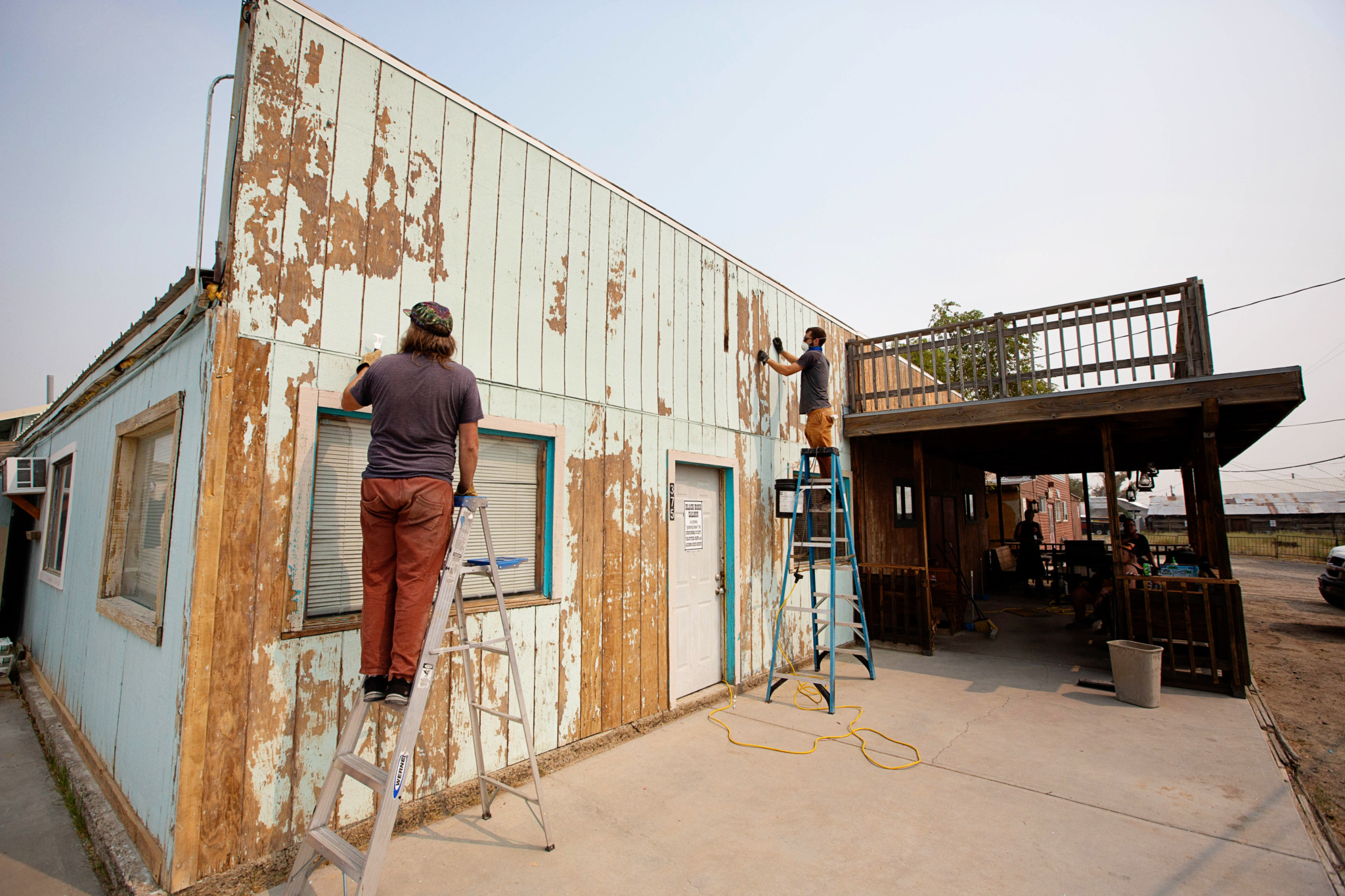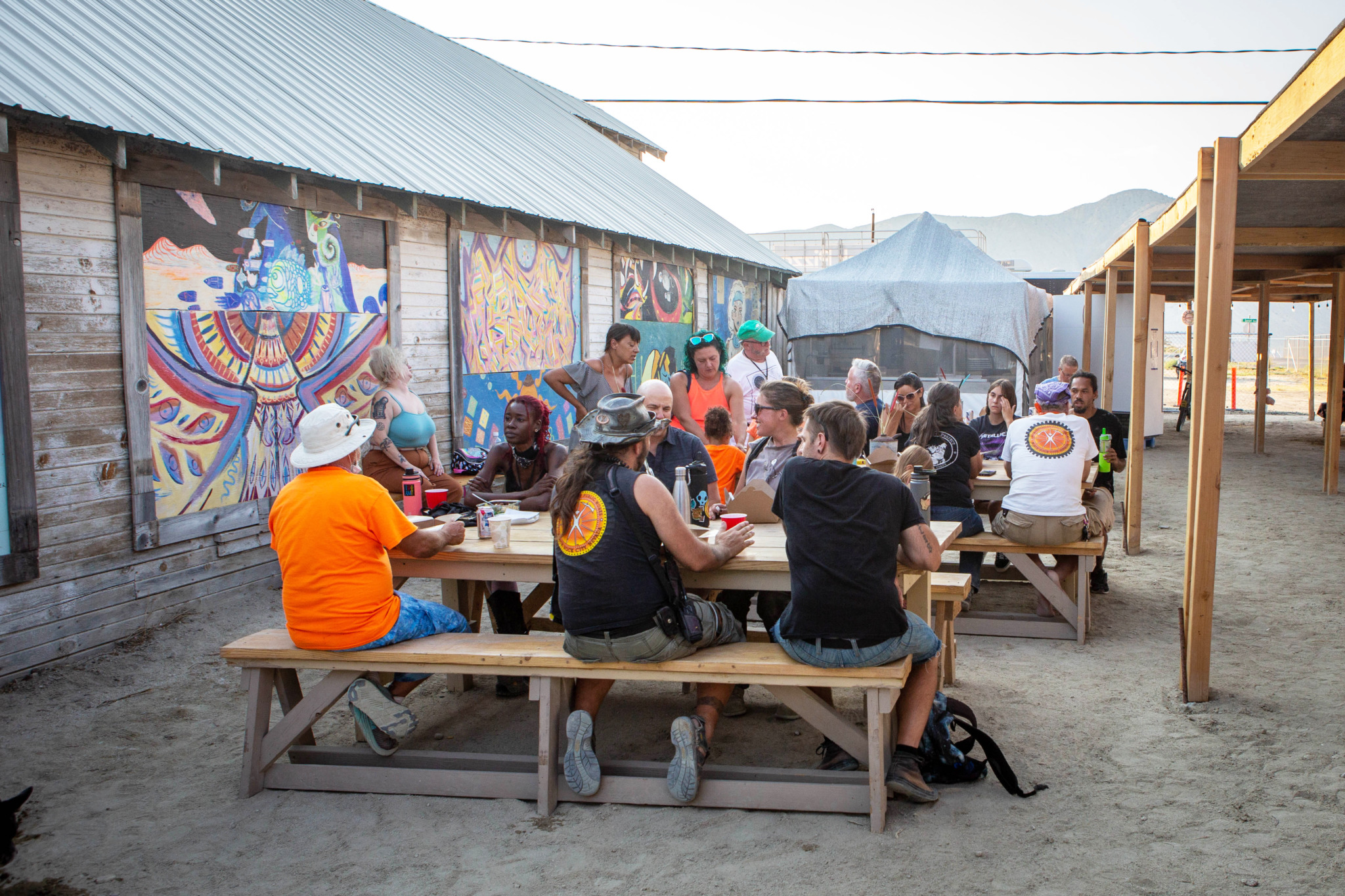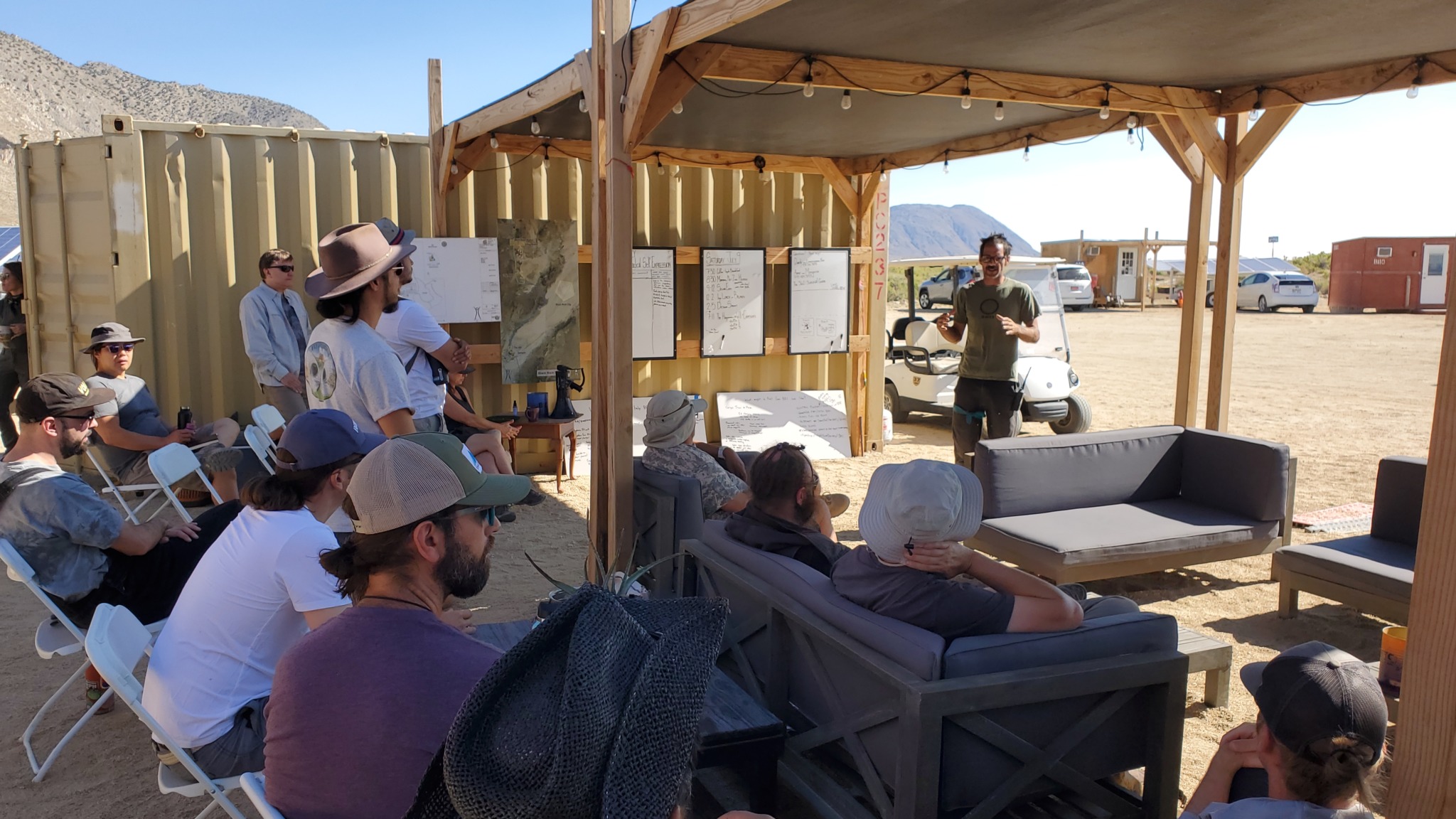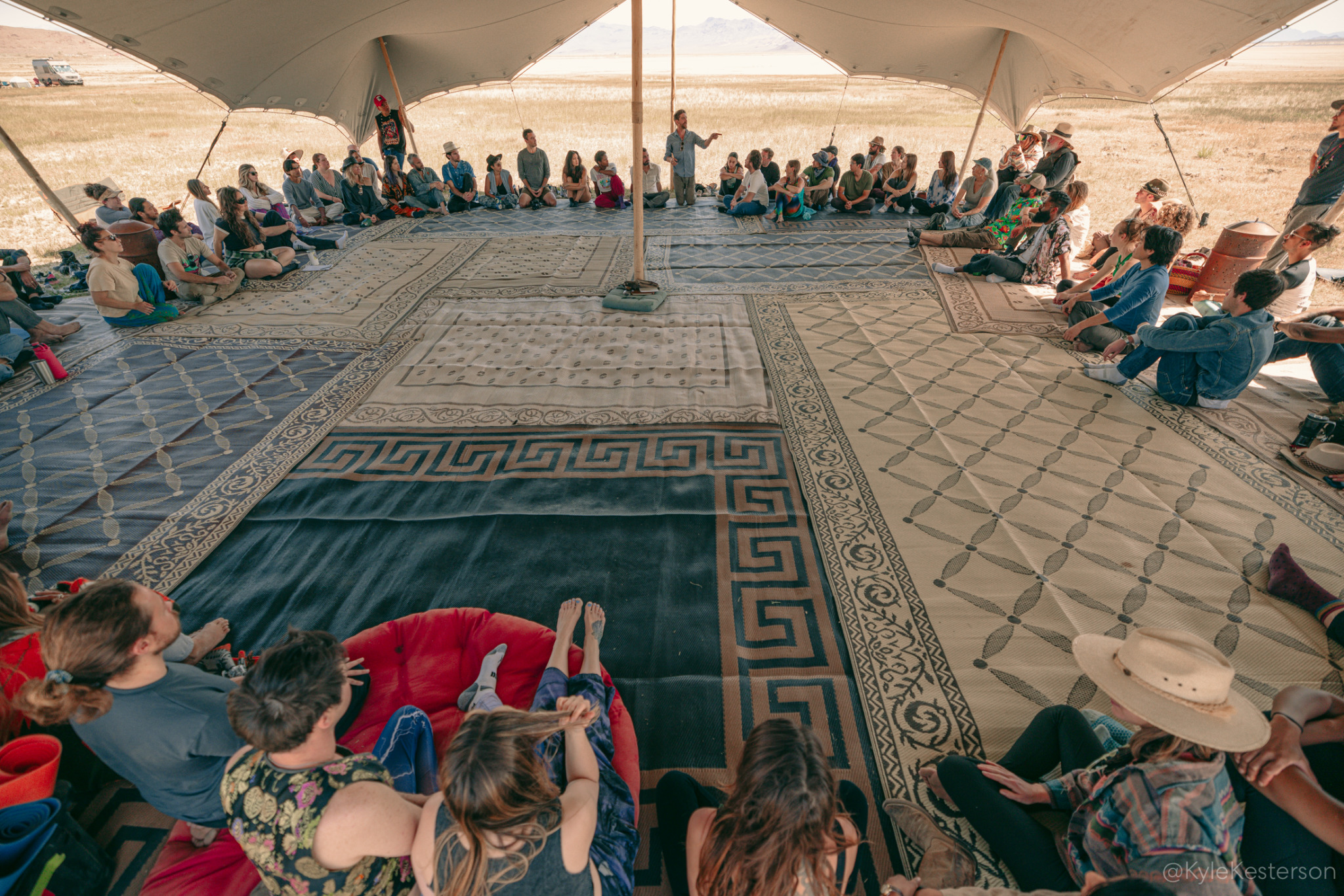Since Burners first frolicked in the Black Rock Desert way back in 1990, the culture and ethos we’ve created has trickled into the wider world. In the beginning, our imprint was small and obscure. But slowly, year after year, as Black Rock City grew and morphed, Burning Man culture began to have a considerable impact on the wider world.
As the Regional Network expanded and Burning Man culture evolved, Burners around the world built ephemeral cities and events, cultivating a year-round, global community. Until recently our cities, however magnificent, have remained temporary — rising in fields, deserts, forests and virtual spaces around the world, and then vanishing.
A Year-round Hub to Sustain Burning Man Culture and Community
What if Burning Man was a year-round city built around our 10 Principles? One you could visit, co-create, and learn from? Imagine, if you will, a permanent autonomous zone that will serve as a year-round incubator for art, education, and maker culture.
Instead of isolated pieces we can create a zone of space, a permanent autonomous zone, a culture-jamming community rooted in physical space that eludes formal structures of control through decentralization.
– Writer and poet Hakim Bey
Soon you won’t have to use your imagination. We are building it.
No — this does not mean we’re keeping Black Rock City up and running year round! In addition to being logistically impossible, part of the magic of our desert city is its ephemeral nature.
But we ARE building a permanent hub for Burning Man culture in Northern Nevada. Burners of all capacities, skill sets, and backgrounds are creating a rural center that leads local inclusive growth that will open new opportunities for Burners as well as the Nevadans who call this dusty nook of the world home.
We’re building something we believe in. It won’t happen overnight, and we can’t build it all on our own. This collaborative effort involves you — whether you volunteer, create art, organize, donate, share knowledge, or just drop by to say hello — you are welcome.

To Build a Better World, We Need to Start in Our Own Backyard
With the Black Rock City event on pause during the COVID-19 pandemic, we gained time to evaluate Burning Man Project’s mission: “to facilitate and extend the culture that has issued from the Burning Man event into the larger world.”
We realized: to truly have an impact on the world, we need to begin in our own backyard. We looked up and down at our systems, our workers, our connection with our communities, and evaluated each of the impacts of our existence on the local community in light of our mission.
Burning Man and Gerlach are inextricably linked. Burning Man Project currently owns more than half of the commercial property in Gerlach. And we’ve had a steady presence on Fly Ranch since we acquired the 3,800 acre property in 2016. Every year, our dusty city rises in the midst of a region whose year-round residents live with extremely limited access to employment and education, unreliable utilities such as power and internet, and next to no services and amenities such as grocery stores, hospitals, and childcare.
If you’ve read Jessica Bruder’s book Nomadland: Surviving America in the Twenty-First Century, or watched the film it inspired, you’ve seen the harsh reality facing Northern Nevada’s residents. In the film, Fern (played by Frances McDormand) takes to the road after losing her job in Empire, the factory town immediately adjacent to Gerlach. This story plays out in endless permutations throughout Northern Nevada, and in thousands of other remote communities across the United States.
Applying All We’ve Learned to Build an Inclusive New Economy
We want this corner of the world to be livable for people of all means. In Northern Nevada, Burners have an opportunity to build an inclusive new economy, one that brings not only jobs, but much-needed infrastructure and services to Gerlach, Empire and neighboring communities. The model we set in motion can ultimately serve other towns and regions across the US that similarly lack economic opportunities and basic amenities.
“What an immense opportunity before us,” observed Matthew ‘Chef’ Kwatinetz, Burning Man Project Board Member and Senior Director of Nevada Operations. “If we are to be something more than ephemeral, something more than a mirage rising in the desert once a year, we must leave a positive trace. When people ask us who we are, and where they can find us, they must be able to go to a place and see our influence the other 51 weeks of the year. That place most naturally is Gerlach.”
In 2021, during what we called the Hot Gerlach Summer, staff, local residents, Black Rock City organizers, and so many others came together to build physical prototypes, sustainable systems, new infrastructure, and community amenities across a 25 mile area. We went from engaging approximately 75 people in the region during the summer of 2020, to more than 2,500 people in the summer of 2021 across a variety of properties.

And the work continues. Together we are building a new economy, a new community, a new rural way of being in the world. Our efforts are to stave off gentrification while simultaneously supporting culturally rich spaces that offer new, regenerative ways for people of all walks of life to thrive. And no, it’s not too much to ask.
Three Focus Areas: Sustainability, Education, Recreation
The properties we own and operate in Northern Nevada are embedded in the local community and are integral to growing our presence and commitment in the region. Rather than letting them sit dormant, we are activating them to drive inclusive economic growth that closely aligns with Burning Man’s 10 Principles.
Thanks to generous contributions specifically designated for our Northern Nevada projects, our work and investment in Northern Nevada does not financially impact our ability to produce Black Rock City. In fact, the work underway in Northern Nevada supports Black Rock City and its workers — by improving infrastructure, lengthening job contracts, and building new systems that get deployed in Black Rock City (look out for the Baby Wookies and Unicorn solar units that will be powering the Man this year). These projects have the potential to bring about cultural, social and economic returns that will help Burning Man and Northern Nevadans flourish in the decades ahead.

Following a year of discussions with the community and local government, and review of previous plans for Gerlach, we engaged with graduate researchers at the NYU Urban Lab to identify reasonable options for inclusive growth. Growth requires new industry and we’ve identified three sectors — sustainable energy, education, and recreation — as having the most potential to create jobs and open up valuable opportunities for Northern Nevada locals and Burners alike.
Sustainable Energy
Situated in the midst of abundant sources of solar and geothermal energy, Burning Man Project’s Northern Nevada properties are being activated to support our 2030 sustainability goal of getting Black Rock City off fossil fuels. We’re applying the skills and technologies we’ve acquired and over two decades of experience in the desert to create new local opportunities and jobs in the green economy.
Already up and running, the 360 is a residential village and maker space where camps, art and mutant vehicle crews can store and work year-round on their projects near Black Rock City. The 360’s proximity to our desert city enables Burners to dramatically reduce use of fossil fuels to transport art and infrastructure to Black Rock City. We’ve also deployed a fleet of solar trailers and arrays to power Fly Ranch, the 360, Black Rock City 2022 infrastructure, and the Man (which is 100 percent solar-powered in 2022).
At Fly Ranch, our 3,800 acre ranch in Northern Nevada, we’re making headway on our goal to produce public benefits as an agricultural site with regenerative cycles for food, water, power, shelter, waste, and air. On this land we regularly host ecologically sustainable stewardship days, labyrinth walks, and nature walks. Recently, Burners Without Borders and participants in LAGI 2020, the Fly Ranch Design Challenge, camped out in a small area of playa that opens onto the Hualapai Flat. LAGI teams came together to connect with the land, partner with the Pyramid Lake Museum and Visitor’s Center, and explore how they could build prototypes for their projects. Our hope is that these projects will become the foundational, regenerative infrastructure for Fly Ranch and demonstrate how Burning Man can achieve the goals in our 2030 Sustainability Roadmap.


Education
At its core, Burning Man culture is a teaching and co-learning ecosystem. We spent the past two years making Burner knowledge more accessible via Burning Man Hive and the The Gerlach Workforce Development Center (GWDC). Located in the heart of Gerlach, GWDC has already hosted three in-person semesters that welcome all — locals, tribal members, Department of Public Works crews and other Burning Man staff, and anyone else who’s interested — to upgrade their trade and professional skills, learn how to create sustainable and non-commodified businesses, and more. GWDC courses will be accessible to all; to date more than half of participants have received scholarships to attend.
The medium-term plan is to create a campus in Northern Nevada that integrates education of all kinds. We’re already in conversations with universities to create a joint program that will offer accredited courses.
Recreation
Much of Northern Nevada’s current economy is based on recreation. In addition to the thousands of Burners who make the journey to Black Rock City every year, visitors come to the region to camp, hunt, and explore the Black Rock Desert–High Rock Canyon Emigrant Trails National Conservation Area. Creating more infrastructure and amenities to support recreation has potential to become a year-round driver of local employment and economic growth. Burning Man Project’s Northern Nevada properties will provide accommodation and community spaces to tourists and travelers in the area — from events at the 360 maker space, to an art trail, RV park, public hot springs, lodging at the Desert Club Hotel, and even a mini golf course.
We Can’t Wait to Tell You More
We have so much more to say! This first piece in our series about our work in Northern Nevada offers just a glimpse into the thinking behind all these emerging projects. We can’t wait to tell you more about the 360 rural maker space, village and sculpture park; the Desert Club Hotel, incubator and community plaza; more housing in Gerlach for staff and visitors; a trailer park right in Gerlach, and all the other projects we’re working on. To learn more, one great place to start is Thinking Big in a Small Town, a recent Burning Man Live interview with Matt Kwatinetz.
But here, first, we wanted to delve a little into the why, and to share our excitement about the huge rebirth that happened in Burning Man Project during the COVID-19 pause. Watch this space for stories about each of these emerging projects and the experiences of people who live and work in Northern Nevada. If you’re in Gerlach anytime soon, make sure you stop by to say hello, or plan ahead to participate in one of our community events in the area.
Cover image: the 360 (Photo by John Curley)


Perhaps you should consider that the West is having a massive water shortage now , fires everywhere and in Desert areas flash flooding. This seems to get much worse every year and any new projects should take this under consideration. On another note where is the water coming from for this years Burning Man ?
Report comment
I have so much that I can tell you about our hydrological basins and where our water comes from. I don’t think I could do it in a comment though. But, could extremely shortly, the town of Gerlach and our surrounding communities, because we are small and because the hydrological basins are big, have an excess of usable water. Water rights and usage are such a complicated topic in Nevada, since forever. That said, I’ve been northern Washoe County, we are still in very good shape.
Report comment
Decommodification now apparently means running RV parks for tourists. Gotcha.
Report comment
It’s the world’s largest RV parking lot for 1 week a year. That’s an amazing accomplishment.
Report comment
>Imagine, if you will, a permanent autonomous zone that will serve as a year-round…
They always fails due to power struggles. That’s why they were called TEMPORARY Autonomous Zones. The lessons have already been learned.
Report comment
permanent (semi) autonomous zones are called local government
Report comment
You have autonomy in permanent autonomous zones so long as you don’t get caught. I wonder if they will have a sheriff and a holding cell in this new PAZ.
Report comment
Huzzah for beginning to design and build permanent facilities in cooperation with area residents. I love that you intend to serve and enrich northern Nevada communities and environments and the animals, plants and humans that live there. Hopefully, wise leadership will help the Burning Man event pivot from burning wood and other materials to creating sustainable art and architecture that can enrich other public spaces and/or create a massive permanent Black Rock sculpture park that will super charge year round tourism in the area. Pivoting to composting organic art and architecture is also worth considering. Love to you all for your vision and dedication!! ❤️
Report comment
“Burning Man Project currently owns more than half of the commercial property in Gerlach” & “Our efforts are to stave off gentrification…”
Some of the things that Burning Man is doing in Gerlach are great. And be honest, some are causing big problems. Burning Man owning half of the commercial properties and buying every other property they can IS causing gentrification. Property values have soared, and people who want to work and live here (for jobs other than Burning Man) cannot find housing. There is a serious housing shortage now, as you know.
This town needs a diversity of employers, not just Burning Man. And those employees need places to live and other businesses to frequent.
Report comment
This is so amazing! It’ll be like living in TedX lectures – 24/7, all the time, forever and ever.
Report comment
Thank you for this project. It makes perfect sense, it is the right thing to do, you have very good information bandwidth-relationship – locally and globally, and it is a hard problem.
The Burner Community is global, with massive expertise, experience, and resources.
Your challenges will be:
1. Setting the expectations of your stakeholder locals for an agile/design thinking approach, where failure is for learning.
2. Managing the numbers of ideas coming your way while gently managing the expectations of contributors.
3. Balancing the short term and long term, sustaining good projects in the long term.
4. Being respected by potential partners considering collaborating.
5. Managing all the information flows short term and long term, and creating an accessible and comprehensible project history.
6. Benchmarking.
7. Solving the Mythical Man Month scaling challenge.
8. Articulating a vision that is inspirational and specifically actionable.
Five year plans is a potential tool. It might be useful for BLM to divest some land to the vision.
Hahaha, we trust you to do it!
Report comment
I like the idea of this for various reasons, but also interested on how this project would address impacts to species. Deserts tend to have a high diversity of reptiles and other species. If you have a permanent hub where people can continually visit, there’s higher potential of introducing non-native species whether it be plants or insects or others. Also, another thought is that instead of having a large group of people coming in via planes or vehicles once a year, with the hub you’ll have people coming throughout the year and not everyone can afford or owns electric vehicles, so increase in emissions is another concern. The hub itself may be sustainable but there are still environmental impacts to consider. I also agree with some of the comments above regarding gentrification and lack of diversity. Although this project seems to aim at helping the locals please consider how creating this type of hub could also bring in more people outside of the community wanting to build more structures and creating more of a tourist destination that increases cost of living.
Report comment
Hi,
I’ve never been a burner yet but my children are virgin burners this year. Then, I’ve been reading a lot about the history, news and so on.
If I understand well, you are currently trying to make from a temporary event “Leaving No Trace” (one of the 10 principles) a thing that will induce major changes. You’re trying to make an utopia (the Burning Man that is sort of an ideal vision of what the society could be, definition of utopia) into a permanent society… You know as well as I do that people are people, money is everywhere, and the best ideas (think of Marx philosophy) usually lead to not so good realities!
I hope you will succeed anyway. I wish you the best and will follow the project with great interest. In the mean time, long live the Burning Man!
Martine
Report comment
This all sounds great – until climate change makes Gerlach uninhabitable – happening sooner than later. Then what??
Report comment
I want to know more about this mini golf course
Report comment
Comments are closed.